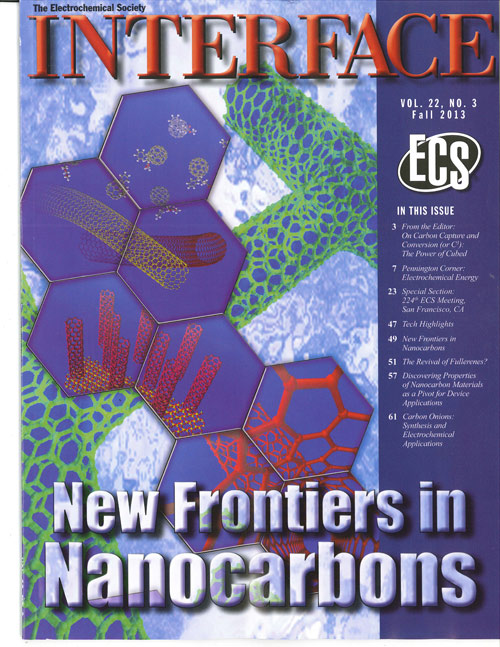Small but Mighty
Two Lehigh physicists have made significant contributions to an international magazine’s special issue on nanocarbon materials.
Slava V. Rotkin and Tetyana Ignatova produced the cover illustration for the fall 2013 issue of the Electrochemical Society’s journal Interface and wrote an article about the versatility and potential of nanocarbons. Rotkin, an associate professor of physics, and Ignatova, a Ph.D. candidate, generated 3-D graphics for the image. Monica Shell ’14, a design major, designed and colored the image under the supervision of Johanna Brams, a senior instructional technologist.
The Interface issue is titled “New Frontiers in Nanocarbons.” The article by Rotkin and Ignatova is titled “Discovering Properties of Nanocarbon Materials as a Pivot for Device Applications.” Nanotechnology has been defined as the engineering of systems with dimensions smaller than 100 nanometers. Nanocarbons come in a variety of shapes and geometries, ranging from nanoparticles, nanowires and nanotubes to graphene—a lattice of interlocking hexagons—and hollow spherical molecules called fullerenes. Nanocarbons have a high degree of mechanical stability and stiffness, unusual interfacial thermal conductance and optical performance.Particularly striking is the unprecedented strength of nanomaterials no more than a layer of atoms thick.
Those properties have opened up applications in photovoltaic cells, liquid crystal devices, batteries and supercapacitors, electron field emitters and other electronic devices. Nanocarbons are also used as fillers in automobile tires, tennis rackets and other products. Ignatova studies the interaction of photoluminescent RE ions with DNA-wrapped NT hybrids. By examining how the brightness of RE light emission diminishes, she has deduced the attraction or repulsion between DNA and RE at distances that cannot be resolved by microscopy.
Rotkin and his students conduct research on a variety of nanocarbon projects. With Anand Jagota, professor of chemical engineering, Rotkin has investigated the wrapping of nanotubes (NT) with DNA strands in an effort to make it easier to manipulate the tubes in solution. Recently, Rotkin’s group collaborated with the Los Alamos National Laboratory in a study of gel-like materials that mimic the environment inside the body or living cell.
Posted on:


